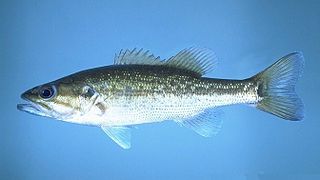
The spotted bass, also called spotty, or spots in various fishing communities, is a species of North American freshwater fish belonging to the sunfish family (Centrarchidae) of the order Perciformes. It is noted for the rows of dark spots below the lateral line, which give it its common name. One of the black basses, it is native to the Mississippi River basin and across the Gulf states, from central Texas through the Florida panhandle. Its native range extends into the western Mid-Atlantic states and it has been introduced into western North Carolina and Virginia. It has also been introduced to southern Africa, where it has become established in some isolated waters as an invasive species.
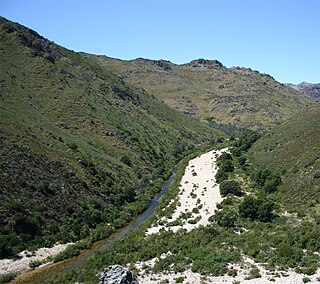
The Olifants River is a river in the northwestern area of the Western Cape Province of South Africa. The upper and main catchment area of the Olifants river is around Ceres and the Cederberg mountains. The Clanwilliam and Bulshoek dams are located on the river and provide water for the towns and farms along the watercourse. The river is approximately 285 km long with a catchment area of 46,220 km2. It flows into the Atlantic Ocean at Papendorp, 250 km north of Cape Town.

The Berg River is a river located just north of Cape Town in the Western Cape Province of South Africa. It is approximately 294 km (183 mi) long with a catchment area of 7,715 km2 (2,979 sq mi) and empties into the Atlantic Ocean. About 65% of the Berg River area is under agriculture. The major towns in the Berg River area are Velddrif and Laaiplek near the coast, and Piketberg, Hopefield, Moorreesburg and Darling further inland.
Austroglanis barnardi is an endangered species of catfish. It is one of three members of the family Austroglanididae. It is also known as the spotted rock-catfish or Barnard's rock-catfish.

Pseudobarbus is a ray-finned fish genus in the family Cyprinidae. The type species is Burchell's redfin. The scientific name is derived from the Ancient Greek pseudes ("false") and the Latin word barbus. This genus contains some of the South African redfins. It was originally proposed as a subgenus, but has since been found worthy of recognition as a full genus.
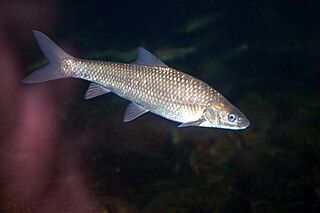
The Cape whitefish or Berg-Breede River whitefish is a ray-finned fish species in the family Cyprinidae. It was formerly placed with the South African redfins in Pseudobarbus. It is tetraploid. Its closest living relative is the sawfin.

The Clanwilliam yellowfish is a ray-finned fish species in the family Cyprinidae. It has long been placed in Barbus, the "wastebin genus" for barbs, by default; however, the species is increasingly being restored to related yellowfish genus Labeobarbus which seems a much more appropriate placement. It is hexaploid like the other yellowfish, among which it is more closely related to the smallscale yellowfish than to the largescale yellowfish.
The Twee River redfin or simply Twee redfin is a ray-finned fish species in the family Cyprinidae. It was formerly placed with the South African redfins in Pseudobarbus. It is tetraploid. Its closest living relative is the Clanwilliam redfin.

The largemouth yellowfish or Vaal-Orange largemouth yellowfish is a ray-finned fish species in the family Cyprinidae. This large freshwater barb is found in southern Africa.
The sawfin, also known as Clanwilliam sawfin, is a ray-finned fish species in the family Cyprinidae. It was formerly placed with the South African redfins in Pseudobarbus. It is tetraploid. Its closest living relative is the Cape whitefish . This sizeable cyprinid can grow to over 40 centimetres (16 in) long and weigh more than 3 kg.

The Eastern Cape redfin is an African freshwater fish species in the family Cyprinidae, this appears to be a species complex rather than a single species.

The smallscale redfin is a freshwater fish in the family Cyprinidae which is endemic to South Africa. It is threatened by habitat destruction and the impact of invasive species.

Burchell's redfin, also known as the Tradouw redfin, Tradou redfin or Breede redfin, is an African freshwater fish species in the family Cyprinidae. P. burchelli is the type species of its genus Pseudobarbus, and like all of these is tetraploid. The Berg River redfin is a very close relative.
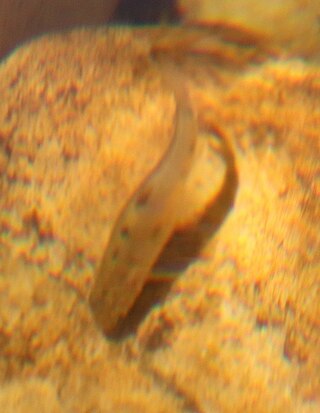
The Berg River redfin or Berg redfin is an African freshwater fish species in the family Cyprinidae. The Burchell's redfin, the type species of its genus Pseudobarbus, is a very close relative. The Berg River redfin is tetraploid.
The fiery redfin is an African freshwater fish species in the family Cyprinidae.

Galaxias fontanus, the Swan galaxias, is a species of fish in the family Galaxiidae. It is endemic to eastern Tasmania, Australia.
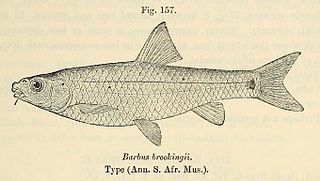
The border barb is a ray-finned fish species in the family Cyprinidae. It is the only species in the genus Amatolacypris. Like Pseudobarbus, it is tetraploid.
The redfin shiner is a freshwater fish in the family Cyprinidae. The redfin shiner is most commonly found in the Ohio and Mississippi River basins, as well as in drainages of the Great Lakes. The diet of the redfin shiner consists mostly of algae and small insects. This species prefers calm water in low-gradient streams over substrates of gravel or sand with some vegetation.

The Verlorenvlei redfin is a species of barb endemic to the Verlorenvlei River in South Africa.
Sedercypris, commonly known as Cedarberg redfins, is a genus of fish in the family Cyprinidae endemic to the Clanwilliam Olifants River system in South Africa.













